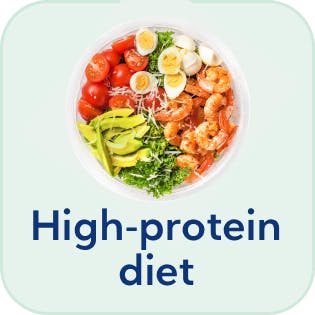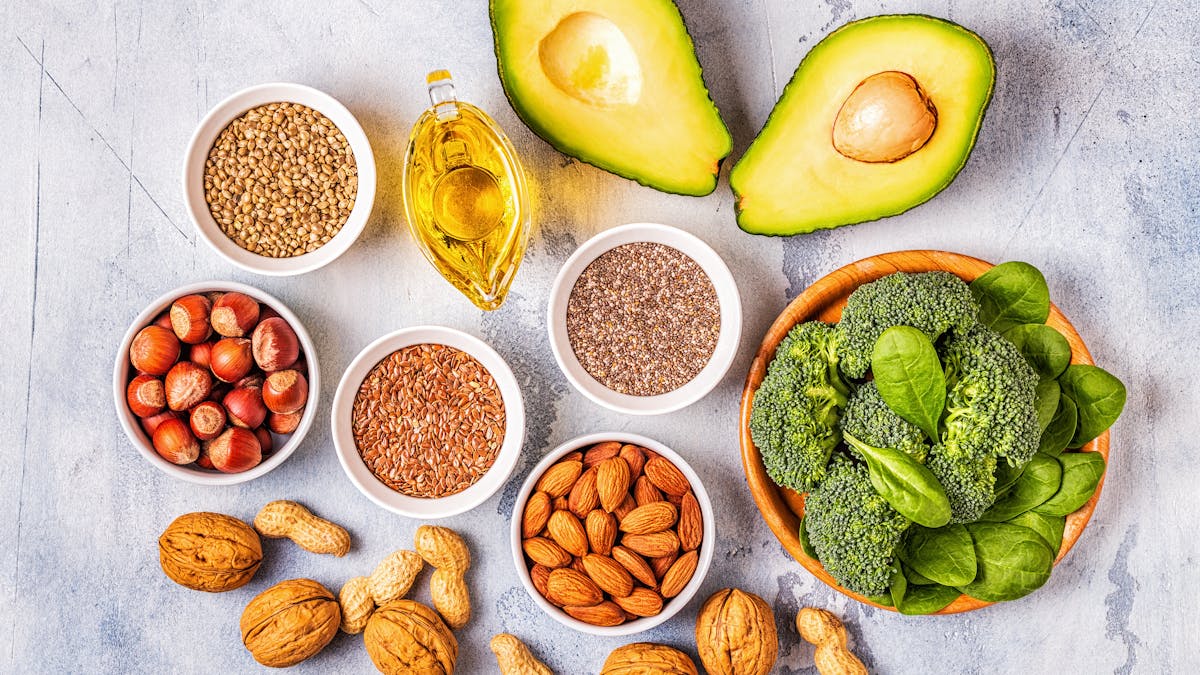Evidence based
How to calculate net carbs
Have you ever wondered what the difference is between total carbs and net carbs? Do you know which one is better to track if you’re eating a low-carb diet — or if it matters at all?
This guide will explore these questions to help you understand which approach is right for you.
When you calculate net carbs for whole natural foods, net carbs are the total carbs in a particular food minus the fiber.
Whole foods
For processed foods, you may need to subtract sugar alcohols as well (more on this in the section on sugar alcohols)
Processed foods
Given the calculations, total carbs are almost always higher than net carbs.1 At Diet Doctor, we define the different levels of carbohydrate reduction according to net carbs. Below are our three levels, stratified by net carbs and including estimates for total carbs:
- Strict low carb — less than 20 grams of net carbs (30 grams of total carbs)
- Moderate low carb — 20 to 50 grams of net carbs (30 to 70 grams of total carbs)
- Liberal low carb — 50 to 100 grams of net carbs (70 to 130 grams of total carbs)
Our advice
- Focus on net carbs when eating whole, natural foods such as vegetables, fruit, beans, and legumes.
- Focus on total carbs when eating processed food products with added fiber, such as bars and baked goods.
Why measure net instead of total carbs?


The main reason to track net carbs is that dietary fiber doesn’t provide calories or affect glucose and insulin the same way as non-fibrous carbs.2
If you have diabetes, pre-diabetes, metabolic syndrome, or obesity, scientific evidence demonstrates significant benefit from limiting your carbs.3 But research also shows potential benefits from eating fiber.4 Therefore, one helpful approach could be to eat high-fiber foods that are low in net carbs, such as low-carb vegetables like leafy greens, broccoli, and zucchini.
Here are some examples:
- Half of an avocado has 9 grams of total carbs, but only 2 of those grams are net carbs because 7 grams are fiber carbs.
- One cup of broccoli has 11 grams of total carbs, 6 grams of net carbs plus 5 grams of fiber carbs.
- Two-thirds of a cup of raspberries has 11.5 grams of total carbs, made up of 5 grams of net carbs and 6.5 grams of fiber carbs.
If you enjoy a lunch made with chicken thigh, avocado, broccoli, and raspberries, you would eat 31.5 grams of total carbs, of which 13 grams are net carbs and 18.5 grams are fiber. That means you would — with just this meal — reach your daily carb limit if you follow a diet aiming for 30 grams of total carbs.
But if you follow a diet aiming for 20 grams of net carbs, you have some room to add high-fiber carbs at dinner and potentially benefit from the extra fiber intake.
That’s why our recommendation is to track net carbs when eating whole, unprocessed foods. Fiber isn’t just “free” from a calorie and blood sugar perspective; it’s potentially beneficial for weight loss, blood sugar control, and short-term satiety. And tracking net carbs lets you eat more fiber!
See if some of your favorites are on our list of the top 15 high-fiber, low-carb foods.
Why measure total carbs?
It’s easier to measure total carbs — no subtraction necessary!
The benefit of measuring total carbs is most evident when it comes to manufactured or packaged products.
The effect of the natural insoluble fiber found in fruit and veggies is well known and has been well-studied. It’s called insoluble fiber because your body doesn’t absorb it at all.5
Naturally-occurring soluble fiber is a little different. Soluble fiber forms a gel and increases the viscosity of the digested food. While some soluble fiber may get absorbed, it is more likely that it gets fermented by gut bacteria. Therefore, soluble fiber can contribute a small number of calories, but it doesn’t usually impact blood sugar and insulin significantly.
However, the fiber added to packaged food products is often the kind of soluble fiber that can contribute to increases in blood sugar and insulin.
For instance, isomaltooligosaccharide (IMO) significantly raises blood sugar and insulin levels.6 Food manufacturers often count IMO as fiber and subtract it from total carbs to market a low-net-carb product. Unfortunately, your body will not agree.
Other examples of added fibers are inulin, xanthan gum, tapioca fiber, and chicory root. While none of these will likely cause the same adverse reaction as IMO, we still recommend caution as many of these added fibers have not been extensively studied.
Because of the unwanted potential effects of these ingredients, we recommend counting net carbs for whole natural foods and total carbs for processed food products.
Pro tip
Outside the US, most nutrition labels remove fiber from the total carb count, automatically reporting net carbs. So make sure you read the label carefully. If it has IMO in the ingredients, the label may not reflect carb content accurately.
Sugar alcohols
Sugar alcohols don’t occur in significant quantities in natural foods. However, they’re common in processed food products and baked goods.
Some, like erythritol, do not meaningfully contribute any calories or affect blood sugar. However, xylitol and mannitol can make a small contribution, while maltitol, sorbitol, isomalt, and glycerin make a more significant contribution.7
Conclusion
When it comes to net versus total carbs, our advice is simple:
- Count net carbs for whole foods. Just subtract the naturally-occurring fiber from the total carbs.
- Count total carbs for packaged or processed foods, and try to stay away from products that have IMO or maltitol.
What if you eat a mix of whole foods and processed foods? You can target a middle point between your net carb and total carb goals. It may not be an exact science but should get you close.
For the next step, consider reading our related guides
How to calculate net carbs - the evidence
This guide is written by Dr. Bret Scher, MD and was last updated on June 19, 2025. It was medically reviewed by Dr. Michael Tamber, MD on November 17, 2021.
The guide contains scientific references. You can find these in the notes throughout the text, and click the links to read the peer-reviewed scientific papers. When appropriate we include a grading of the strength of the evidence, with a link to our policy on this. Our evidence-based guides are updated at least once per year to reflect and reference the latest science on the topic.
All our evidence-based health guides are written or reviewed by medical doctors who are experts on the topic. To stay unbiased we show no ads, sell no physical products, and take no money from the industry. We're fully funded by the people, via an optional membership. Most information at Diet Doctor is free forever.
Read more about our policies and work with evidence-based guides, nutritional controversies, our editorial team, and our medical review board.
Should you find any inaccuracy in this guide, please email andreas@dietdoctor.com.
Except on a zero-fiber and zero-“sugar alcohol” diet (which is extremely rare except for those on a carnivore diet) in which case they are the same. ↩
Soluble fiber is mostly non-absorbed by the intestine, but may contribute slightly to calorie absorption. However, it’s generally accepted that the human body doesn’t produce the enzymes needed to break down insoluble fiber:
Gut Microbes 2017: Dietary fiber and prebiotics and the gastrointestinal microbiota [overview article; ungraded]
Your gastrointestinal tract can’t digest naturally-occurring insoluble fiber, so it passes through without being absorbed. Therefore, insoluble fiber won’t adversely affect your blood sugar or insulin levels.
International Journal of Molecular Sciences 2017: Gut fermentation of dietary fibres: physico-chemistry of plant cell walls and implications for health [overview article; ungraded] ↩
Nutrients 2020: Impact of a ketogenic diet on metabolic parameters in patients with obesity or overweight and with or without type 2 diabetes: A meta-analysis of randomized controlled trials [systematic review of randomized trials; strong evidence]
Diabetes Research and Clinical Practice 2018: Effect of dietary carbohydrate restriction on glycemic control in adults with diabetes: A systematic review and meta-analysis [strong evidence] ↩
Diabetes Care 2019: Should viscous fiber supplements be considered in diabetes control? Results from a systematic review and meta-analysis of randomized controlled trials [systematic review of randomized trials; strong evidence]
Obesity Reviews 2011: Effects of dietary fibre on subjective appetite, energy intake and body weight: a systematic review of randomized controlled trials [systematic review of randomized trials; strong evidence]
International Journal of Obesity 2014: Satiety and energy intake after single and repeated exposure to gel-forming dietary fiber: post-ingestive effects [randomized trial; moderate evidence]
The Journal of Nutrition 1997: Dietary fiber decreases the metabolizable energy content and nutrient digestibility of mixed diets fed to humans [randomized trial; moderate evidence] ↩
Journal of Food Composition and Analysis 2002: Individual sugars, soluble, and insoluble dietary fiber contents of 70 high consumption foods [nutrient analysis study; ungraded] ↩
Journal of Functional Foods 2020: Ingestion of isomalto-oligosaccharides stimulates insulin and incretin hormone secretion in healthy adults
[randomized trial; moderate evidence]Journal of Insulin Resistance 2018: The effects of soluble corn fibre and isomaltooligosaccharides on blood glucose, insulin, digestion and fermentation in healthy young males and females
[randomized trial; moderate evidence]
↩Diabetes, Obesity & Metabolism 2021: Gastric emptying of solutions containing the natural sweetener erythritol and effects on gut hormone secretion in humans: A pilot dose-ranging study [randomized controlled trial; moderate evidence]
American Journal of Physiology, Endocrinology & Metabolism 2016: Gut hormone secretion, gastric emptying, and glycemic responses to erythritol and xylitol in lean and obese subjects [randomized controlled trial; moderate evidence]
European Food and Research Technology 2015: Sugar alcohols—their role in the modern world of sweeteners: a review[overview article; ungraded] ↩









